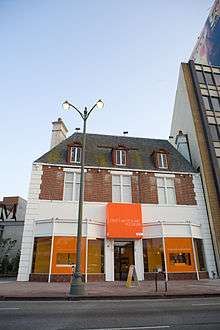Craft and Folk Art Museum
 | |
| Established | 1973 |
|---|---|
| Location | 5814 Wilshire Boulevard, Los Angeles, CA 90036 |
| Coordinates | 34°03′44″N 118°21′20″W / 34.06222°N 118.35556°WCoordinates: 34°03′44″N 118°21′20″W / 34.06222°N 118.35556°W |
| Type | Art museum |
| Director | Suzanne Isken |
| Website | http://www.cafam.org/ |
The Craft and Folk Art Museum (CAFAM), was incorporated in 1973 and began formal museum operations in 1975. It is the successor to the commercial gallery, The Egg and The Eye Gallery, which opened November 1, 1965 in the same historic building. Like the present-day museum, the gallery showed contemporary craft objects and folk art. A popular restaurant on the mezzanine featured a long list of ethnically inspired omelettes. When the commercial gallery was converted to a private, nonprofit museum, the restaurant took the name of the former gallery, The Egg and The Eye. The restaurant closed forever, as part of a major renovation, on June 30, 1989. The renovated museum re-opened May 12, 1995, then closed temporarily at the end of 1997, and finally re-opened February 11, 1999.
Overview
Located on Los Angeles’ Museum Row on Wilshire Boulevard, and across from the George C. Page Museum and La Brea Tar Pits, CAFAM presents six original exhibitions a year ranging from the local to the global; traditional to contemporary. CAFAM is the only museum in Los Angeles showing exclusively craft, folk art, and design. CAFAM works to recognize emerging artists and make art accessible to all audiences.
History
In 1965, a group of women, led by artist Edith R. Wyle (grandmother of actor Noah Wyle), called the "Folk Art's High Priestess" by the LA Times, channeled their passion for indigenous art into The Egg and The Eye Gallery. The gallery sold fine craft and traditional art from world cultures; the restaurant served over 50 varieties of omelettes. The success of this concept spurred the formation of the nonprofit Craft and Folk Art Museum in 1973. When the gallery was converted to a museum, the restaurant took on the gallery's former name: The Egg and The Eye. From the beginning, CAFAM was a “living museum” offering artist-led workshops and educational programs. CAFAM held early shows for now-prominent artists, including Frank Romero, Otto Natzler, Dale Chihuly, and Sam Maloof. Edith Wyle was CAFAM's Artistic Director from 1973 - 1984, when she retired. At that point, she became a member of the Board of Trustees, and took the title of Founder/Director Emeritus. In 1976, CAFAM initiated Los Angeles’ first multicultural festival, the International Festival of Masks. This two-day celebration of folk art, dance, music, and food drew up to 40,000 people through 1994. When Los Angeles hosted the Summer Olympics in July 1984, the Festival of Masks was chosen to be an official event of the Olympic Arts Festival; it was produced over a three-day weekend, July 20 - 22, 1984. After 24 years, the restaurant closed forever at the end of June 1989, when the museum had to move temporarily during renovations. The museum was in residence in the historic May Company department store from November 1989 through the end of 1992. Moving the offices and the library next door (at 5800 Wilshire) to its original building at 5814 Wilshire, CAFAM mounted exhibitions in various off-site venues and hired the architectural firm of Hodgetts + Fung to reconfigure the museum, reopening as a merged structure May 12, 1995. At the end of 1997, CAFAM closed due to financial difficulties; at the time, it was believed to have shut down for good. The permanent collection was sold at auction; the library was given to the L.A. County Museum of Art Research Library; and the institutional archives (staff files, 1965 - 1997) were given to UCLA Young Research Library Special Collections. However, Patrick Ela, who was CAFAM's Administrative Director from 1975 - 1984 and then Executive Director until his resignation in 1996, working with Al Nodal, the General Manager of the L.A. Department of Cultural Affairs, developed a partnership between the CAFAM Board and the City of L.A., which allowed the museum to reopen after 14 months in February 1999.
The Founder of the museum, Edith Wyle, died October 12, 1999, and the following year the City of L.A. honored her with the placement of a commemorative plaque at the corner of Stanley Avenue and Wilshire Boulevard, proclaiming the intersection as "Edith Wyle Square."
The building was originally designed by Gilbert Stanley Underwood in 1930 as a mixed-use commercial space. It was renovated twice for The Egg and The Eye by Guy Moore, and then extensively renovated by Hodgetts + Fung in 1995. The original facade remains almost completely intact.
Artistic Philosophy and Exhibitions
CAFAM’s exhibitions examine cultural traditions, artists, and social concepts.
External links
- CAFAM website
- Edith R. Wyle Oral History Interview, Archives of American Art
- Finding Aid for the Craft and Folk Art Museum Archives 1965-1995, UCLA Library Special Collections
- Edith R. Wyle Research Library of the Craft and Folk Art Museum in the Los Angeles County Museum of Art Library